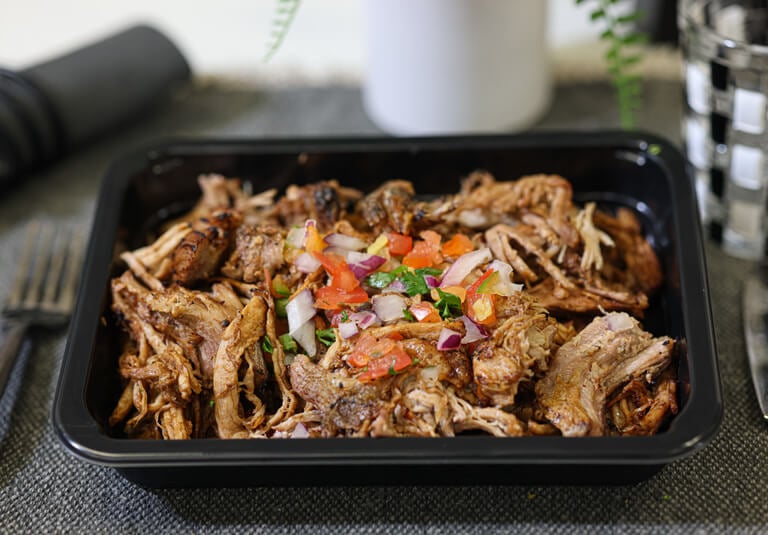Slow-Cooked Pulled Pork Shoulder Recipe

Slow-Cooked Pork Shoulder Recipe
Slow-Cooked Pork Shoulder Roast Recipe Table of Contents
Slow-Cooked Pork Butt Recipe Description
Flavor and convenience combine in this slow-cooked pork roast recipe. Use it as a big dinner for your family get together, or as a meal prep recipe to pre-cook your protein for the week.
Pulled pork is made with pork shoulder (also called the Boston butt). This looks like a roast but shreds easily when cooked low and slow.
Ingredients for this Slow-Cooked Pork Butt Recipe

Ingredients needed for Slow-Cooked Pork Roast.
- Pork Shoulder/Butt Roast – 2-4lbs
- Onion – 1
- Cumin – 4Tbsp
- Olive Oil – ½C
- Granulated Garlic – 1Tbsp
- Oregano – 4Tbsp
- Brown Sugar – ½C
- Salt – 1Tbsp
Kitchen Tools For This Slow-Cooked Pork Roast Recipe

Kitchen Tools needed for this Slow-Cooked Pork Roast recipe.
- Baking Pan
- Chef’s Knife
- Measuring Cups
Step-by-Step Cooking Directions for Slow-Cooked Pork Roast:
- Begin by preparing the seasoning rub you’ll be applying to the pork roast. Add 4 Tbsp cumin, 1 Tbsp granulated garlic, 4 Tbsp oregano, ½ C brown sugar, and 1 Tbsp salt to a bowl, and mix. You may also prepare this rub in bulk, and store it as a shelf stable seasoning option.

Combine your seasonings in a bowl.
- Add ½ C olive oil to the rub mixture. Fully incorporate the oil into the seasonings to make an oily paste. This step allows the rub to better adhere to the roast throughout cooking, and imparts a delicious, crispy crust.

Adding the olive oil creates a paste which will adhere to the roast.
- Be sure to wash your hands thoroughly before seasoning the roast. You may also elect to wear culinary appropriate gloves for this step. Always use proper food safety protocols when handling raw meat

Always use proper raw meat handling techniques.
- Using your hands and fingers, you will apply the seasoning rub to the outisde of the pork roast. Be sure to rub an even coating on all sides of the roast, and use your fingers to push the seasoning into its grooves and crevices.

Take the time to rub seasoning into all the roast’s crevices.
- Roughly chop 1 onion and place into your baking pan. You will place the roast directly on top of this onion bed. Preheat your oven to 350º.

Create a bed of onion on which to place the roast.
- The onion will add flavor and help prevent the roast from sticking to the pan or burning. It will also make cleanup easier. Cooking a pork shoulder roast traditionally takes 20 minutes per pound at 350º.

Bake at 350º for about 20 minutes per pound.
- Precise cooking time will vary, so always use an internal meat thermometer to ensure your roast is done. Pork must reach a minimum of 145º. Once finished, place the baking pan onto a trivet and allow the roast to rest for at least 15 minutes prior to carving and serving.

Allow the roast to rest before carving.
- Allow the slow-cooked pork shoulder to rest. This allows the juices to not to run out all over the cutting board. In order to prevent the juices to run out of the pulled pork* allow the meat to rest. This way the juices remain within the roast. Then, with a fork or with a gloved hand gently pull the pork shoulder apart to create pulled pork.

Slow-cooked pork roast is delicious and easy.
Serve this slow-cooked pork roast to your liking. Between slices of bread, accompanied with mashed potatoes or roasted vegetables, or even added to a dish such as Pasta Alfredo. You can even portion the roast into daily meals, and freeze any excess for meal prep convenience. See how to shred pulled pork in the video below:
Types of Pork and their Flavor
Heritage Pig Breeds
Heritage pigs are a breed of pig that is not cross-bread with other breeds. These breeds include Berkshire, Red Wattle, and Duroc. These pigs have darker meat with richer flavor, juiciness, and marbling. The benefit to using these breeds of pig is there is no need to brine them or add marinades/sauces for tenderness since they come with so much flavor and juices naturally.
Non-Heritage Pig Breeds
Non-heritage pork refers to pork that comes from pig breeds that are not considered heritage breeds, meaning they are typically commercially bred pigs raised for rapid growth and lean meat production, often with less flavor and marbling. If cooking with this more common type of pork a brine is best.
Sides & Suggestions for this Slow-Cooked Pork Roast Recipe
This pork is super delicious, and you have a range of options for serving. Try using some for a BBQ pulled pork sandwich.
* Allow any cut of meat to rest before slicing for 10 min. Reduce time for steak and smaller cuts of meat.